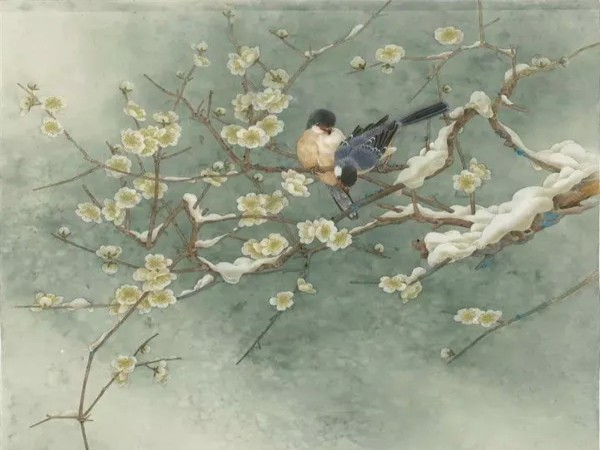Traditional Chinese Painting
Traditional Chinese Painting, which had no definite name in ancient times and was generally known as "danqing". The word “danqing” refers to two kinds of minerals which can be made to scarlet and cyan pigments, afterwards refers to paintings on scrolls of silk or rice paper.
From modern times onwards, to distinguish it from imported Western painting (also known as oil painting), it is called Traditional Chinese Painting or simply Chinese painting. It is a form of pictorial art created using the brush, ink and pigments unique to China, following the forms of expression and artistic rules that have developed over time.
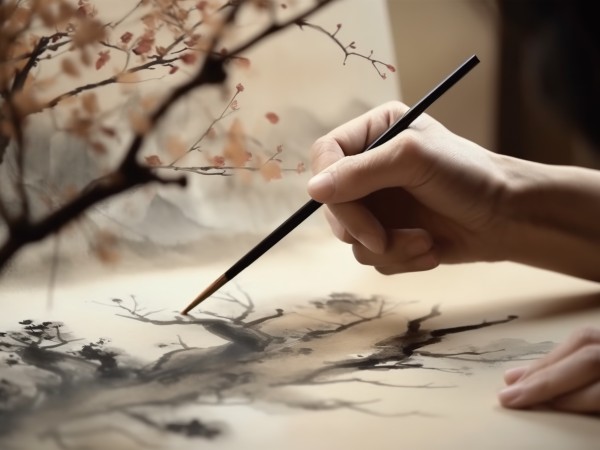
Traditional Chinese Painting can be classified according to the materials used and the methods of representation, including ink painting, heavy color painting, light color painting, detailed painting, expressive painting, contour painting and others. They can also be classified according to subject matter, such as paintings of figures, landscapes, flowers and birds, and others.
Traditional Chinese Painting comes in a variety of formats, including long scrolls (or hand scrolls), horizontal scrolls, vertical strips, half screens, full-size art books and others. In addition, it is painted on folding fans and round fans.

In terms of its ideological content and creative process, Traditional Chinese Painting reflects the social consciousness and aesthetic taste of the Chinese nation, as well as the understanding of the ancients towards nature, society and aspects related to politics, philosophy , religion, morality, literature and art, being one of the Four Arts (playing instrument, play chess, calligraphy and painting) of Chinese culture.
Characteristics of Traditional Chinese Painting
Traditional Chinese Painting has distinctive characteristics. According to Xie He's criticism of the Nan Dynasty, it is valued for its "spiritual liveliness", not limited to the mere physical similarity of objects, but emphasizing the expression of the author's subjective feelings. Chinese painting strives to "represent the spirit", seeking a sense of "beauty between the similar and the unlike". Attention is paid to the spirit of the brush and ink, with brush technique requirements: flat, round, retention, heaviness, and variation.
As for the ink, it is divided into five colors: burnt, dense, heavy, light and clear. "Using the brush for structure" is emphasized, no attention is paid to the focal point of perspective, nor is the effect of the light and color change of the environment on the objects emphasized; the arrangement of white space and the "impulse" of objects are valued. Compared with foreign works of art, Western painting can be said to be an art of "representation", while Chinese painting is an art of "expression". Chinese painting seeks to represent "spirit" and "state".
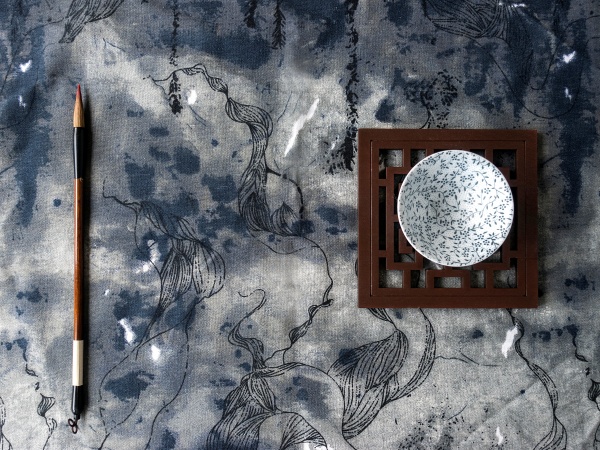
Painting Tools
"Brush, ink, paper and inkstone" are indispensable tools for ancient Chinese literati, known as the "Four Treasures of Study". Its importance is not limited to writing and painting, but Chinese literati give them deep cultural and emotional meaning. The stories of the great masters of calligraphy and painting, as well as those related to the brush, ink, paper and inkstone, are countless throughout the dynasties.
Paintbrush
The animal hair paintbrush is a Chinese invention that has influenced writing traditions in Asia, including Korea, Japan, and others. The brush is divided into hard bristles, soft bristles, and mixed bristles, with the hard bristles represented by wolf hair (yellow wolf tail), the soft bristles by goat hair (goat beard), and the mixed bristles with a combination of both. Chinese calligraphy and painting are closely linked to the use of the brush. In particular, brushes from Huzhou (present-day Shannan, Zhejiang), brushes from Xuanzhou (present-day Jing County, Anhui), and brushes from Jinxian, Jiangxi, are the most prized.
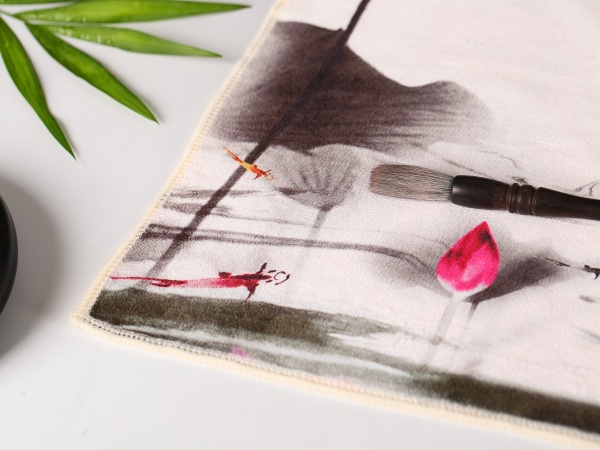
Ink
Ink is divided into two types: "oil ink" and "pine ink". Oil ink is produced by processing with tung oil or incense smoke; Pine ink is produced by smoke processing pine branches. The ink produced in ancient Huizhou has always been appreciated by literati. Huizhou ink has the nickname "unchanged gold." Pigments are also divided into two types, which produce different effects: one is of plant origin, such as flower blue, vine yellow, carmine and peony red, etc., with fine transparency but may fade. over time; the other is of mineral origin, such as cinnabar, red and green pigments, ocher, yellow earth, lead white, etc., with strong opacity and coverage, which does not fade over time.

Paper
Chinese painting uses a wide variety of types of paper, such as Xuan paper produced in Xuanzhou, bark paper from Sichuan, cotton cloth paper from Yuxian, Henan, cotton paper from Liyang, Hunan, etc., and even fabrics such as silk and satin are used as materials for paintings. However, Xuan paper is the most common, with high production, good quality and ability to highlight the essence of Chinese painting; In addition, it is cheaper than silk, so Xuan paper has almost become synonymous with paper used in Chinese painting. Xuan paper is divided into raw Xuan and processed Xuan. The processed Xuan has been treated with alum water, so the ink does not penetrate easily and allows for precise and meticulous drawing as well as multiple layers of coloring, being suitable for detailed paintings; raw Xuan has not been treated with alum water, so once the ink hits the surface, it is fixed, without the possibility of modification, and also allows a wide variety of ink changes, so it is used more in expressive paintings.
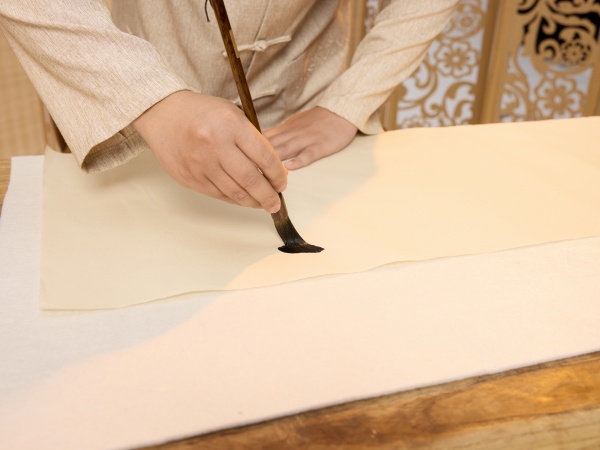
Inkstone
The inkstone is used to grind the ink. It is required to be fine, smooth and produce ink easily, and the resulting ink should be fine and uniform without impurities. The most famous inkstones are the She inkstone from Shexian, Anhui, the Duanxi inkstone from Duanxi, Guangdong, the Tao inkstone from Gansu, and the Chengni inkstone from Shanxi, known as the Four Great Inkstones. Ink. Often, the ancients spent their entire wealth to obtain a renowned inkstone.
In addition to the Four Treasures of the Study, there are many other painting-related tools, such as stamps, stamp ink, brush holders, brush basins, brush holders, and bookends, among others. In a broad sense, the Four Treasures of Study also include the elements mentioned above.

The classification of Traditional Chinese Painting
Traditional Chinese Painting is mainly classified into three broad categories: characters, flowers and birds, and landscapes. Superficially, it is divided into these thematic categories, but in reality it is used as an artistic expression of concepts and ideas. The so-called "three-branch division of painting" summarizes three aspects of the universe and life: character painting represents human society and relationships between people; landscape painting represents the relationship between man and nature, fusing man with nature; while the painting of flowers and birds shows the variety of life in nature, showing a harmony between humans and nature. The classification of Traditional Chinese Painting into characters, flowers and birds, and landscapes is actually a philosophical thought underlying the sublimation of art, where the three combine to form the entire universe, complementing each other, representing the true essence of art. .
In terms of its development history, traditional Chinese painting has its roots in the Spring and Autumn and Warring States period, more than two thousand years ago. Two silk paintings from the Warring States era of the State of Chu established the national style of Chinese painting with their vitality, concise brushstrokes and flowing lines, expressing a sense of the divine. During the Eastern Han Dynasty and the Wei, Jin, Northern and Southern dynasties, Buddhist and Taoist image painting gradually became the aesthetic mainstream. From the Tang Dynasty onwards, character painting gradually became the main subject of painting, while during the Song Dynasty, skills in landscape painting and flowers and birds were highlighted. During the Yuan Dynasty, landscape painting further became a subject of free expression, dividing into two broad types: the northern style, known as blue-green landscape, and the southern style, known as ink landscape. During the Ming Dynasty, the field of literary painting opened up, and during the Qing Dynasty, traditional Chinese painting flourished, emerging a large number of outstanding painters represented by the "Eight Eccentrics of Yangzhou". In modern and contemporary times, traditional Chinese painting has inherited its tradition and has given rise to many acclaimed works of art.
Character Painting
The history of character painting in China dated back to over 4,000 years ago. According to records, there were already murals during the Shang and Zhou dynasties.
Gu Kaizhi of the Eastern Jin Dynasty was the first painter in the history of Traditional Chinese Painting to explicitly propose the idea of "representing spirit with form." Yan Liben of the Tang Dynasty was also skilled in character painting, as were Wu Daozi, Han Gan, among others, who made significant contributions. After the Tang Dynasty, there were even more painters dedicated to character painting, present in all dynasties. Character painting in Traditional Chinese Painting is one of the main categories and appeared before landscape painting and flower and bird painting. It is mainly divided into Daoist painting, ladies' painting, portraits, customs painting, story painting, among others. Character painting seeks to portray personality vividly and vividly, with vitality and a combination of form and spirit. His method of conveying spirit often involves representing personality through environment, atmosphere, posture, and dynamics. Therefore, in the theory of Traditional Chinese Painting, character painting is also known as "spirit-transmitting painting".
To paint character painting well, in addition to inheriting tradition, it is also necessary to understand and study the basic shape, proportions and anatomical structure of the human body, as well as the laws of movement of the human body, in order to accurately shape and represent precision the form and spirit of the characters. There are various rendering methods for painting characters, each with its own strengths, such as the outline method, the fill method, the ink splatter method, the drawing and rubbing method, among others.
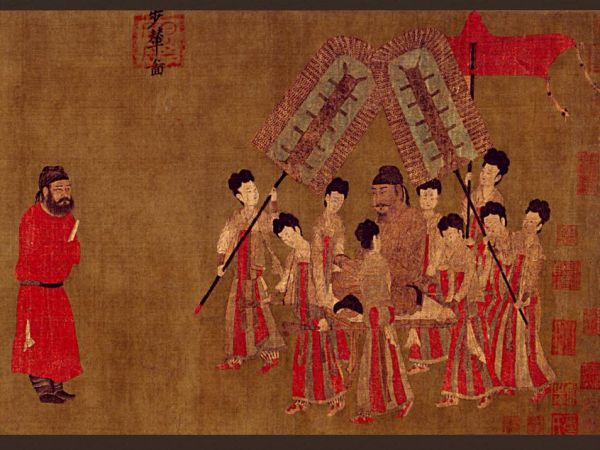
Landscape Painting
Chinese Landscape Painting, known as "Shanshui", is an artistic genre whose main theme is the representation of natural landscapes. It developed gradually during the Warring States and Six Dynasties periods, but was still mainly used as a background for character painting. By the Sui Dynasty and Tang Dynasty, numerous independent landscape paintings had already been produced. During the Five Dynasties and the Northern Song dynasty, this genre reached its maturity and numerous artists emerged, thus becoming one of the main categories of Traditional Chinese Painting. It mainly features shapes such as "teal", "golden", "pitted", "light pink" and "ink and wash". In terms of artistic expression, it focuses on the composition of space and the expression of mood.
The elements that make up landscape painting include mountains, water, rocks, trees, buildings, boats, bridges, wind, rain, sun, clouds, fog, and the weather characteristics of spring, summer, autumn, and winter, among others. Landscape painting methods can be roughly divided into two categories: "blue-green landscapes" and "freestyle landscapes". Teal landscapes focus on details and the lines should be natural, while freestyle landscapes focus more on the general idea and rarely pay attention to details.
The term "freestyle" refers to "expressing the inner meanings that you wish to convey from your heart through painting." Therefore, some people believe that the mood of freestyle landscape painting should be higher. However, in traditional Chinese aesthetics, especially during the feudal era and in relation to imperial examinations that required perfect calligraphy, bluish-green landscapes that had an affinity with the regular lowercase were more appreciated by ancient scholars, and occupied a highest place in ancient society. Additionally, many court painters were experts in this style of painting.
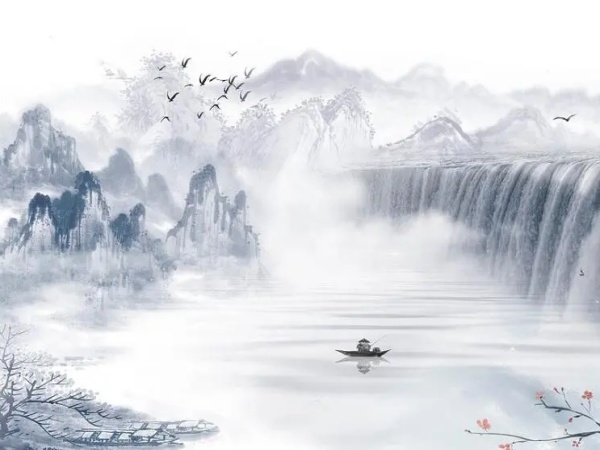
Painting of Flowers and Birds
Flower and bird painting focuses on mainly depicting flowers, bamboo, stones, birds, beasts, insects and fish in the image. Simple designs of birds and fish on pottery four or five thousand years ago are considered the earliest examples of this art form. According to Zhang Yan Yuan's record of the Tang Dynasty in "Chronicles of Famous Paintings throughout the Dynasties", during the period of the Eastern Jin and Southern Dynasties, flower paintings on silk and cloth gradually became an independent category and some specialized painters emerged. During the Five Dynasties and the Two Song Dynasties, this art form reached greater maturity.
Flower and bird painting methods can be divided into two main categories: meticulous style and expressive style. Insects can also be divided into meticulous style and expressive style. Rendering methods include single outline (also known as double outline), outlined, fill, boneless, ink splatter, among others. Like landscape painting, it has a long history. The learning steps of flower and bird painting include copying, drawing from life, and creating.
Subjects represented include bamboo, orchids, plum trees, chrysanthemums, peonies, lilies and lotuses; birds such as chickens, geese, ducks, cranes, cuckoos, kingfishers, magpies and eagles; insects such as parrots, butterflies, bees, dragonflies and cicadas, and other insects such as grasshoppers, crickets, ants, snails, spiders, and others.
